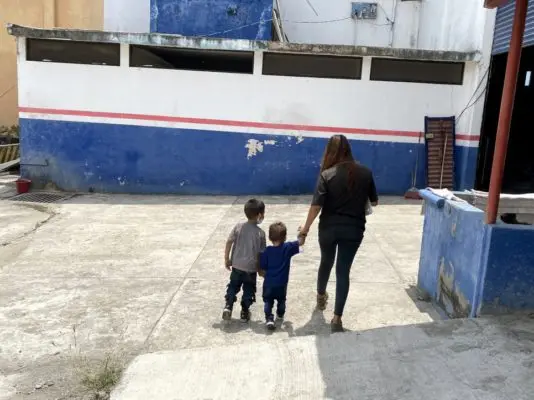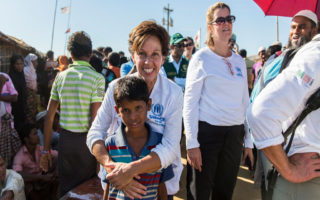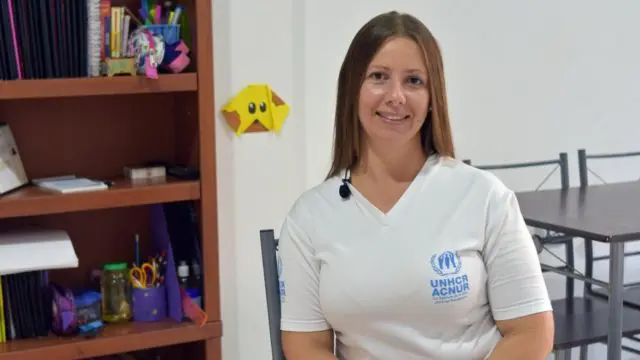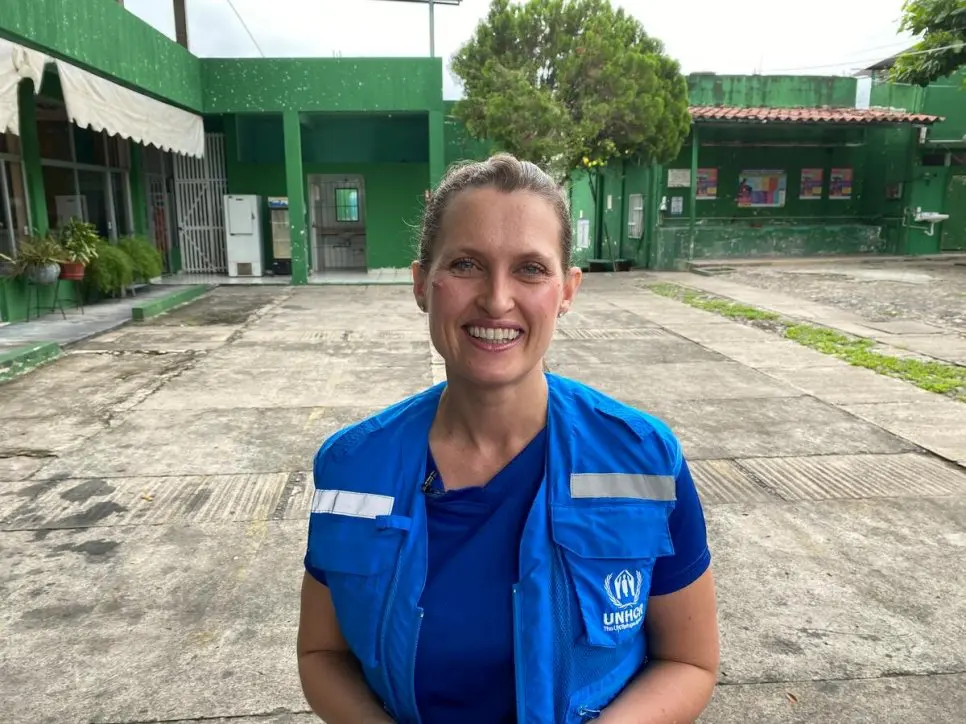
Kristin Riis Halvorsen, UNHCR’s head of office in Tapachula, Mexico, at a shelter for asylum-seekers. © UNHCR/Pierre-Marc Rene
UNHCR has more than 17,300 staff, most of whom are based in the field. Meet Kristin Riis Halvorsen, who runs operations in southern Mexico.
By Tim Gaynor in Tapachula, Mexico
Name: Kristin Riis Halvorsen, 43, from Norway.
Why did you become an aid worker?
For as long as I can remember I’ve cared about justice, or rather, injustice in the world. I was lucky to grow up in a country where there’s a lot of emphasis placed on civil society engagement, and you get involved early. In high school, I raised funds for projects in Afghanistan and South Africa and ensured that visitors from these countries could travel around the region, talk to schools and meet with people. One thing leads to another. When I was studying for my Masters degree in Colombia, I came across a recruitment page for UNHCR. I read it and thought ‘this is interesting and meaningful’ and I applied. A few months later, I got my first job.
What is the most rewarding / challenging thing about your job?
The most rewarding thing about my job is, it’s quite remarkable, a gift, to be able to wake up every day and go to work and feel that what you do is meaningful. In the past 13 years I’ve never had a day when I woke up and thought ‘why am I doing this again?’, because the work to me is always meaningful. We’re close enough to people to see the tangible results of what we do.
I currently supervise four different teams covering the whole of southern Mexico. My job is making sure that the office can operate. The team has grown from 20 staff when I started in 2018. This year we are set to grow to 150 staff, to respond to a huge growth in the numbers of asylum-seekers, mainly from Honduras, El Salvador and Guatemala. People are running for their lives. Ten or 15 years ago it used to be single, able-bodied young men doing this trek across Mexico. Now it’s large family groups. When you see a grandmother, or a seven-months pregnant woman crossing the border, there’s something indicating that the situation back home has just left them really no hope.
For me, the hardest thing is being the person who has to live with the decisions about what we can and cannot do. Sometimes we’re faced with complex, protracted situations where donors at some point start looking elsewhere. In Uganda, it meant sometimes having to stand in front of a woman with four or five children and explain that ‘you’ve been in the country so long, you’re not going to get food anymore.’ For those of us who are close to the people and know their needs so well, to understand that we won’t be able to do everything that’s needed, that’s really heartbreaking. It would have been amazing to live in a world where no one was forced to leave their home. It’s a wonderful job, but I’d love not to do it.
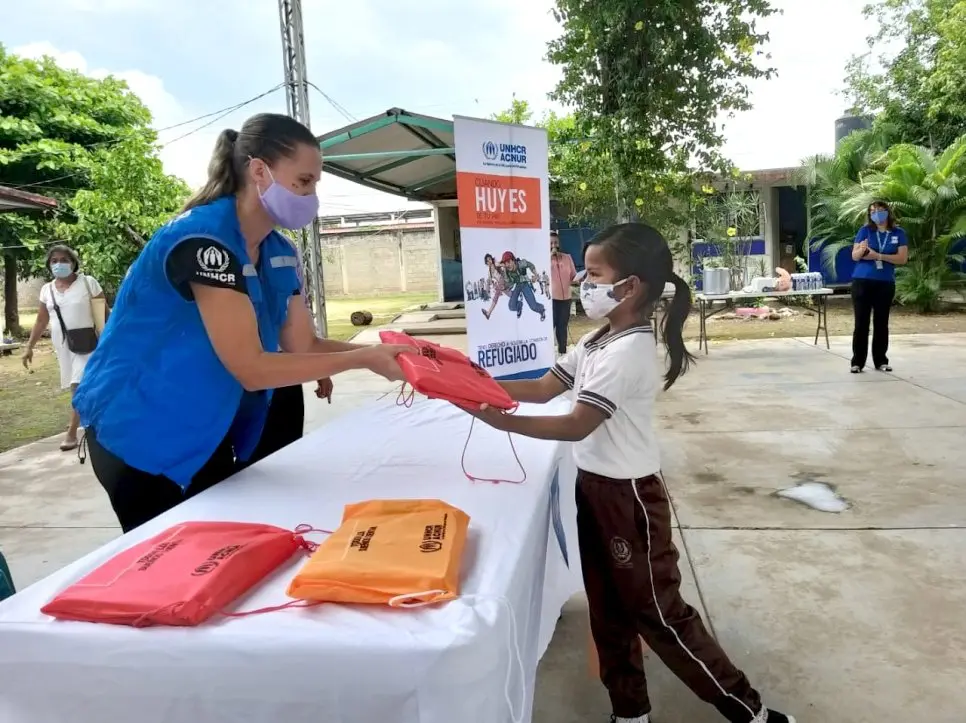
Kristin gives school kits to an elementary school student in Tapachula. © UNHCR/Pierre-Marc Rene
What was your best day at work?
About a month after I arrived in Tapachula we were able to present a play at the town theatre here. It holds about 1,000 people. With the help of local authorities we were able to fill it with young students from around Tapachula, and we presented a play written by two young women whose parents arrived in Mexico as refugees from Brazil and Argentina, fleeing from dictatorships. When the play ended, the children didn’t know they should applaud. But then they started to clap and cheer. It was so rewarding to reach out to a part of the community we don’t usually reach, with a message of inclusion and understanding.
What was your worst day at work?
The face of this one girl keeps haunting me. It was in Rakhine State, in Myanmar, where we would work very hard to reach the more remote camps for internally displaced people. We would move around in by boat to reach these remote locations. There was one camp where the people had been displaced by just a few hundred meters and could see their village, and also the school, although they couldn’t return there. There was this one visit when the children had decided that they would wear their school uniforms. And there was this girl who I already knew, who was sitting in the front row with an impeccable school uniform and she was very well groomed. She was just looking at us with this hope in her eyes, and I just felt incredibly useless. Their school was just 200 metres away and we could not get them back there. We have to look for every possible opportunity to make a difference for that little girl. For every little girl, seeing the years pass and their dreams fade. We should always be looking for ways to do more.
The UN Refugee Agency works in 135 countries helping men, women and children driven from their homes by wars and persecution. Our headquarters are in Geneva, but 90 per cent of our staff are based in the field, helping refugees. This profile is part of a series highlighting our staff and their work.
Your support is urgently needed to help the children, women and men refugees from the North of Central America. Please give now.



